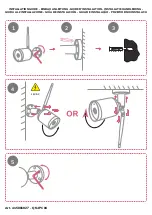
A Lens that Sees with Crystal Clarity
A photo is only as good as the
lens it was taken with.
When it comes to photographic
expression, the lens is the most crucial
element. This is true of any camera,
film or digital, and it remains just
as true in any age. Observing the
advances in digital image processing
technology designed to compensate
for lens aberrations, you would think
that digital image compensation was
the answer to everything. However,
no matter how far digital image
processing technology advances, it will
never rival the descriptive power of an
excellent lens. Some might argue that
an adequate lens is all you need, as
long as you have brilliant compensation
technology. That's not our view. Sigma
is a lens expert, and the DP1x's special
lens is the culmination of years of
lens-related R&D.
Up there with a high-performance
interchangeable lens
The DP1x's integral 16.6mm F4 lens
(equivalent to 28mm on a 35mm
film camera) is built to the same
design as the DP1's, and has the same
outstanding descriptive power. It may
be small, but it's a high-performance
wide-angle single-focus lens designed
to the standards of interchangeable
SLR lenses. Manufactured to exacting
standards, large-diameter (14.5mm)
aspherical glass molds are arranged
in the fourth group. Besides achieving
high-resolution and high-contrast
performance, we have succeeded
in storing the whole lens unit in a
compact lens barrel. Its MTF – the value
indicating lens performance – is on a
par with that of the interchangeable
lenses used in SLR cameras.
Adapting SLR lens technology
for our own purposes
The lens we've given the DP1x is of the
retro focus type, typically used in wide-
angle lenses for SLRs. Besides having
the telecentricity so important in
lenses for digital cameras, retro focus
lenses capture plenty of peripheral
brightness. The lens specially designed
for the DP1x takes full advantage of
this property, successfully ensuring that
the light volume stays the same right
to the periphery, while also minimizing
astigmatism and field curvature.
The disadvantage of the retro focus
lens, however, is that its back focus is
longer than its focal length, and this
inevitably increases the total length
of the lens. In order to keep the total
length as short as possible while still
delivering high image quality, the rear
elements of the DP1x lens include glass-
mold aspherical lenses with a high
refractive index. This has successfully
shortened the total length while
reducing the number of lenses used,
and maintaining high performance.
The use of aspherical glass-mold lenses
also enables advanced correction of
astigmatism and comatic aberration.
A lens for full photographic expression
The DP lens uses the Super Multi-
Layer Coating Sigma has developed
over many years of manufacturing
interchangeable lenses for digital
cameras. Despite the compactness
of the lens-barrel, flare and ghosting
can be effectively suppressed even
when shooting a backlit or semi-
backlit scene, allowing more dramatic
photographic expression.
We've also taken peripheral brightness
into consideration: the drop in
peripheral brightness at the outermost
edge of the screen when the aperture
is released is kept at -1EV, which is on
a par with that of an interchangeable
lens for a precision digital camera. So,
even when you shoot blue skies whose
brightness continues to the horizon,
your pictures will be bright, clear, and
free of light fall-off at the edges.
Encapsulating all the sophistication of
Sigma's optical know-how, this super-
high-performance lens puts SLR-level
photographic expression in the palm
of your hand. The image-quality it
produces is something you really need
to see for yourself.
The lens used in the DP1x is of the retro focus
type. Along with the telecentricity so important
in lenses for digital cameras, retro focus lenses
have a property that enables them to capture
plenty of peripheral brightness. The lens specially
designed for the DP1x takes full advantage of
this property. As well as ensuring that the light
volume stays the same right to the periphery,
it also successfully minimizes astigmatism and
field curvature.
The disadvantage of the retro focus lens,
however, is that its back focus is longer than
its focal length, and this inevitably increases the
total length of the lens. In order to keep the total
length as short as possible while still delivering
high image quality, the rear elements of the DP1x
lens include glass-mold aspherical lenses with
a high refractive index. This has successfully
shortened the total length while reducing the
number of lenses used, and maintaining high
performance. The use of aspherical glass-mold
lenses also enables advanced correction of
astigmatism and comatic aberration.
The DP1x lens features the rear-focus method.
Since retro focus lenses tend to exhibit a high
degree of aberration variation at close range,
which makes it difficult to maintain performance,
this lens employs a rear-focus drive system with
a high capacity for aberration compensation.
The DP1x lens has also been treated with
Sigma's proprietary Super Multi-Layer Coating.
By executing high-quality, high-precision coating
control at a high level, enabling the optimizing
of a higher angle of incidence, Sigma has
succeeded in minimizing the ghosting and flare
that cannot be prevented using conventional
coating techniques.
The construction of
the special-design lens
10 lp
30 lp
Spatial Frequency
Sagittal Line
Meridional Line
The MTF chart gives the results at the wide-open aperture.
C
O
N
T
R
A
S
T
IMAGE HEIGHT (mm)
1
0.9
0.8
0.7
0.6
0.5
0.4
0.3
0.2
0.1
0
0
2.5
5
7.5
10
12.5
Sigma Lens 16.6mm F4 MTF Chart
19






































